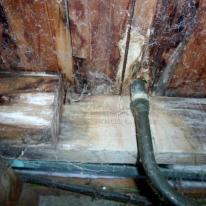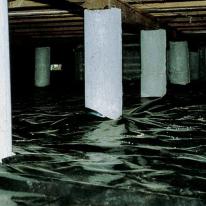Subfloor – mould areas on underside of flooring
Listed under: water heating, hot water cylinders, plumbing, pipes, drains, Subfloor, floors, moisture, leaks, mould, mould health and safety
Cause
Damp subfloor space and/or lack of ventilation
Repair
- remove anything that limits ventilation by:
- clearing away obstructions around the house perimeter such as planting or soil build-up outside the vents
- for painted vents or grilles, removing paint build-up that may reduce the air path space
- clearing rubbish or items stored under the house to improve air flow
- ensure good subfloor ventilation:
- provide not less than 3500 mm² of clear open subfloor venting (grilles or gaps between baseboards) for every 1 m² of floor area
- make ventilation openings high in the subfloor space, near to the underside of bearers
- spread vents evenly around the building perimeter to allow cross-ventilation
- no part of the subfloor more than 7.5 m from a ventilation opening
- where necessary, create new ventilation by:
- replacing or refixing the baseboards with space for air movement between them
- installing new ventilation grilles in sheet cladding/bracing on sloping sites
- cutting additional ventilation openings in concrete or concrete masonry foundation walls and installing surface-mounted proprietary grilles. Take care that openings are not formed in the top course of the blockwork and that reinforcing is not cut
- lay polythene sheeting at least 0.25 mm thick to completely cover the ground under the house. Ensure that the ground is shaped so no water accumulates on top of the polythene. Polythene sheets should be lapped a minimum of 150 mm (preferably taped) and tightly butted up to foundation walls and piles. Weigh down the sheets with bricks or concrete to avoid them being displaced by air movement from subfloor ventilation.
Cause
Leaking water or waste pipe
Repair
-
identify the source and location of the leak. Make a permanent repair, or call a licensed or certifying plumber to make permanent repair. Work on waste pipes and drains must by law be carried out by a licensed or certifying plumber.
-
establish whether the leak is likely to be a one-off problem or stems from old deteriorated pipework/drains or a design or materials fault that may recur. If the latter, discuss potential long-term solutions with a licensed or certifying plumber or NZIBS building surveyor.
Cause
Overflow or leak from wet area fixtures such as bath, shower, handbasin, dishwasher, clothes washer, hot water cylinder
Repair
-
identify the source and location of the leak. Make a permanent repair, or call a licensed or certifying plumber to make permanent repair. Work on waste pipes must by law be carried out by a licensed or certifying plumber
-
if the fixture or appliance is very old and a permanent repair is difficult, consider replacement
-
ensure that the floor dries out completely and that damaged flooring is replaced.
Cause
Inadequately waterproofed tiling in wet area such as no waterproofing membrane under tiles
Repair
-
the only successful long-term solution will be to remove the tiles, repair any damage to substrates or floor then carefully apply/install new waterproofing and retile. See the Level pages on wet area flooring and floor finishes and waterproofing tiled showers.






